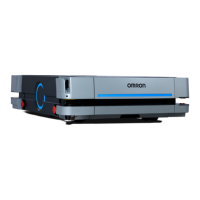Chapter 4: Configuration
The greater the number of AMR's in your fleet, the more wireless resources they consume. For
more information about wireless resource requirements, see: Fleet Operations Workspace Core
User's Manual (Cat. No. I635).
Bandwidth Considerations
All devices that access a Wireless network consume its bandwidth. Use a dedicated network to
restrict wireless network access to AMRs and use security to prevent other devices from access-
ing the network.
Typical bandwidth consumption for a fleet is an average 50 Kbps per AMR. This increases
when you connect multiple AMR's to an EM2100, and actively manage them with MobilePlan-
ner. Bandwidth consumption might increase or decrease depending on the types of commands
and debugging tools that you enable in MobilePlanner. Downloading debuginfo, uploading
ARAM/SNG, and viewing the ARAM log on SNG are other examples of bandwidth usage.
However, the bandwidth consumption is unlikely to exceed 500 Kbps per AMR (0.5 Mbps). A
value of 0.5 Mbps per AMR is within the capabilities of most wireless access points (>=54
Mbps). If you have multiple access points with overlapping coverage, this number is less of a
concern.
The bandwidth usage varies by application. Payload accessories might affect your bandwidth
requirements, for example if the AMR supports a video camera that streams digital video
through the AMR’s wireless interface.
For more information about fleet wireless resources, see: Enterprise Manager 2100 User's Guide.
4.2 Create a Workspace Map
Map Creation Overview
You connect a pendant to the AMR to create the map. The process is described in detail in the
Fleet Operations Workspace Core User's Manual (Cat. No. I635).
NOTE: You may use a smaller size AMR such as an LD-series model for con-
venience of mapping task.
For information on how to use a pendant to create a map, see: Pendant Controls and Oper-
ation Description on page 209.
When you use the HD-1500 to create a map:
l
Put a minimal payload, or preferably no payload on the AMR.
l
Map at low linear and rotational speed and acceleration.
This will ensure the map is more accurate.
If the workspace has open stairwells, docks, ledges or other vertical drops, make sure that you
surround such areas with physical barriers. Barriers must be detectable by the safety lasers'
scanning plane, which is at a height of 175 mm from the floor. Install the barriers before map-
ping a workspace.
31500-000 Rev A HD-1500 Platform User's Manual 130

